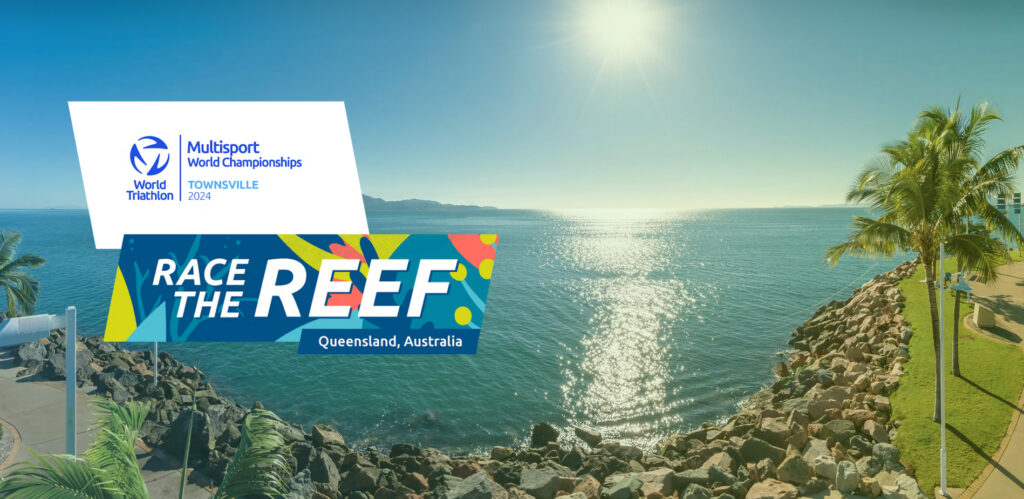I know this one comes ridiculously late as we are currently working on a big update. The Long Distance Aquabike World Championships in Townsville are more than a month ago now. Nevertheless, the outstanding performances we saw downunder certainly deserve to be honoured.
The Australian winter welcomed the athletes with blue sky and warm temperatures on race day. Though the water was still cool enough to make the race wetsuit legal. It was the first World Championship outside Europe since the very first edition in 2017 which happened to be in Penticton, Canada. As not too many athletes from Europe and North America were travelling over the ocean, the race brought up some new faces on the aquabike world’s podium and certainly a few surprises.

The Men’s Race
The fastest swimmer wasn’t a surprise though. 18-year-old US athlete Kieran DOLAN finished the 3 km swim course after only 37 minutes and 16 seconds. Not only that he put almost two minutes into the next aquabike athletes. He was also about half a minute faster than the fastest elite triathlete that day. Who by the way was an US athlete named Jonathan Doland – assumingly Kieran’s older brother. Not being the strongest cyclist, it was clear that it would not be easy for the young Californian to keep his top position.
Young Australian athlete Daniel MCCONNELL was the second aquabike athlete to exit the ocean, but lost more than a minute in transition. So it was Xander MARSH from New Zealand who started the bike leg in second position, closely followed by James THORP from Australia. The Australian-New Zealand duo set an impressive pace on the bike, passing the young American before the end of the first of three laps. Even faster than the two leaders was Melbourne athlete Christo BALL. After losing about 7 minutes in the water, he passed Daniel to be in the fourth position by the end of the first lap and also passing Kieran a bit later to ride himself into podium position. But with the two leaders still 4 minutes ahead, it seemed like Christo had to settle for third place.
It came a bit different though. By the end of the second lap James could not hold Xander’s pace anymore. While the young Kiwi was still cruising at a constantly high pace, the Aussie’s pace dropped quite a bit throughout the third lap on the bike. So it was Xander MARSH who came home with a phenomenal victory.
Christo BALL passed James to take the runner up spot in the overall classification about two minutes behind the winner. While it seemed that James THORP could hold on to the podium, another Australian athlete came flying from behind. Mickie CURRAN finished the swim in 69th position but put down the hammer on the bike. With the fastest bike split by almost four minutes he also passed James on the last kilometres of the race to take third place overall.
Just seconds behind James finished his race in fourth position New Zealands Charlie TAYLOR came in fifth, with his fellow countryman Mike CROWE coming in another 42 seconds later.
Best European athlete that day was Australian based Dutchman Bart HOLLEMANS. With the second fastest bike split of the day, he pushed Kieran DOLAN outside the top 10 just before the finish line, while the leader of the Aquabike.World ranking Frank ERK came in 50 seconds later to take the win in his age group.
In the last editions of the long distance aquabike world championships it’s mostly been the strong cyclists who dominated the rankings. So, it seems remarkable that this year’s champion took the top spot without having a top 3 performance in neither of the disciplines, clearly demonstrating that you can certainly win a big aquabike race with a constantly strong performance over both disciplines.
The Women’s Race
While the men’s race was dominated by athletes from Australia and New Zealand, the result of the women’s aquabike race painted a completely different picture. On the other end of the race there was an astonishing similarity though. The fastest swimmer put about two minutes into her aquabike competitors and about half a minute into the fastest female elite triathlete in the pacific ocean.
In her very first aquabike race Germany’s Jennifer ZENKER who lives in Melbourne, showed an impressive performance in the water, coming out with a clear lead. But that’s where the similarities to the men’s race end. Because Jennifer showed that she’s not only a good swimmer, but also showed no signs of slowing down anytime soon on the bike. Although the competition was certainly by no means weak. While the runner up after the swim Jordyn BLOODE quickly lost ground on the bike to finish the race in 40th place, third out of the water was Amy PRITCHARD. The British athlete has no less than five world championship titles in her age group under her belt, finishing first or second overall in all of those races. And she’s certainly not known for being a bad cyclist.
After the gaps between the top athletes were already quite big after the swim and most of the other female top swimmers quickly lost ground on the bike, the first two places in the women’s race were settled quite early in the race.
After 3 hours, 44 minutes and 43 seconds Jennifer ZENKER finished the race with one of the most impressive performances we have seen in an aquabike race recently. Only two elite (!) triathletes finished the bike leg faster than that. So despite finishing 10 minutes later it was certainly not a bad performance at all by runner up Amy PRITCHARD. By winning her age group Amy is the only athlete – male or female – having won six aquabike world championship titles. Chapeau!
Behind the two outstanding athletes, the race for the third spot on the podium was much closer. By the end of the first bike lap Emily LEWIS had climbed up into 3rd position, after coming out of the water in 12th place. Two minutes later no less than four athletes were separated by only 31 seconds. Morgan FARLEY, 5th after the swim, was passed by Rosie MCGEOCH in T1, but had caught her again after the first bike lap. At that point the two Aussie girls were closely followed by US athlete Felicity JOYCE and their fellow countrywoman Kelly PHUAH who made her way to the front from 32nd place after the swim.
After the second lap, Emily seemed to have secured her third place on the podium, with Felicity and Kelly following about two and a half minutes behind. But in the last lap the Californian showed that she had something left in the tank. She dropped her Australian companion who had to pay tribute for her strong chase in the first half of the bike leg. Felicity got closer and closer but in the end Emily LEWIS managed to hold on to the third spot on the podium by 94 seconds with US athlete Felicity JOYCE coming in in fourth place. The fight for the best Australian became even closer, but Kelly PHUAH managed to hold off Morgan FARLEY by 31 seconds to finish 5th after having had her dropped by almost two minutes by the end of the second bike lap.
About 90 seconds later Melissa WATSON came in 7th, followed by two more Australian athletes Rosie MCGEOCH and Nicola WADEY while best New Zealand finisher in the women’s aquabike race Amanda WOODD rounded up the top 10.
2024 Long Distance Aquabike World Championships Medal Table
| Rank | Country |  |  |  |
| 1. | Australia | 12 | 12 | 10 |
| 2. | New Zealand | 4 | 6 | 2 |
| 3. | United Kingdom | 3 | 3 | 1 |
| 4. | Germany | 3 | 2 | 1 |
| 5. | United States of America | 2 | 3 | 3 |
| 6. | Austria | 1 | 1 | 0 |
| 7. | Belgium | 1 | 0 | 0 |
| 8. | Spain | 0 | 0 | 2 |
| 9. | Poland | 0 | 0 | 2 |
| 10. | Ireland | 0 | 0 | 2 |
| 11. | Netherlands | 0 | 0 | 1 |
Although Townsville is quite a long travel for athletes from Europe or North America, we had aquabikers from 16 nations competing in Downunder. And 11 countries could welcome back their athletes with a gold, silver or bronze medal around their neck. So, this was certainly a quite international field, considering the relatively remote location of the event. Nevertheless, it’s obviously not a big surprise that Australia and New Zealand were the most successful countries in this championship. What is a surprise though, that the motherland of aquabike racing only ended up in 5th place of the medal table this time. While the United States have been on top of the medal table in every single world championship so far – although most of them happened to be in Europe – they had to settle for fifth place behind Great Britain and Germany this time. Although we should add that this is due to the fact that only two of the eight medals won by US aquabikers were in gold. If you go by number of medals they would be in third spot ahead of GB (7) and Germany (4).
The Athlete’s Feedback
The feedback I got from athletes about the event was very positive. What is worth mentioning though is that having more than 800 athletes (triathletes and aquabikers) of very different levels competing on a three lap course with a lot of corners and technical sections is definitely not ideal. Especially for the faster aquabikers it’s unavoidable to get stuck several times behind slower triathletes who started earlier. But other than that the race seemed to be very well organized, and other than in many other world championships aquabikers felt welcome and recognized. This is certainly something where other organizers (especially of big events) have some room for improvement.
